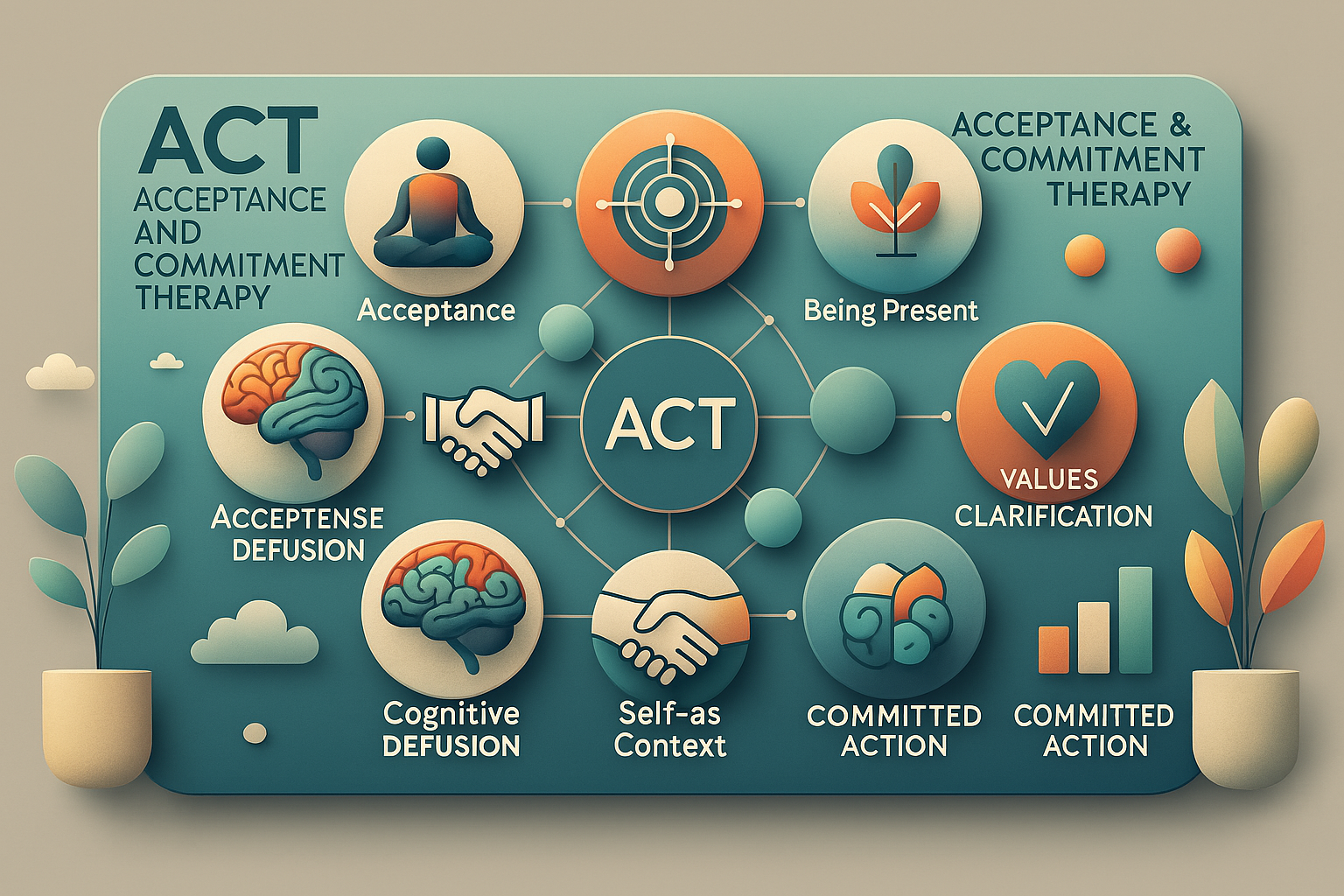Acceptance and Commitment Therapy
Acceptance and Commitment Therapy (ACT): Cultivating Psychological Flexibility
Acceptance and Commitment Therapy (ACT)—often referred to simply as “act”—is a mindfulness-based approach designed to help people navigate life’s challenges by increasing their psychological flexibility. Rather than trying to eliminate difficult thoughts or emotions, ACT encourages individuals to accept them as natural parts of human experience and commit to actions that align with their values.
Key Principles of ACT
1.Acceptance
In ACT, “acceptance” means making room for uncomfortable thoughts and emotions instead of fighting or suppressing them. Acceptance doesn’t imply agreement or resignation—it simply acknowledges that these experiences are real and part of being human.
2.Cognitive Defusion
Cognitive defusion techniques help create distance between you and your thoughts. By recognizing thoughts as mere words or images, you reduce their power to dictate your decisions and emotional states.
3.Present-Moment Awareness
Mindfulness practices in ACT teach you to connect with the “here and now.” Staying present helps reduce worries about the future and regrets about the past, anchoring you in your immediate experience.
4.Self-as-Context
This principle recognizes that you are more than just your thoughts and emotions. By seeing yourself as the observer of these internal experiences, you maintain a stable sense of self that remains constant despite life’s ups and downs.
5.Values
Clarifying personal values is essential in ACT. Values serve as a moral compass, guiding the choices and behaviors that lead to a meaningful life.
6.Committed Action
Once you’re clear about your values, ACT emphasizes taking small, purposeful steps toward them—despite potential discomfort. Committed action is about consistent, values-based behavior rather than short-term relief.
The ACT Hexaflex
All six processes—Acceptance, Cognitive Defusion, Present-Moment Awareness, Self-as-Context, Values, and Committed Action—form the ACT “Hexaflex.” Each element supports and enhances the others, creating a flexible framework for change and growth.
How ACT Differs from Traditional Therapies
•Acceptance Over Avoidance
Traditional therapies often focus on symptom reduction. ACT, on the other hand, places emphasis on accepting unwanted thoughts and feelings in order to reduce their influence on behavior.
•Values-Driven Behavior
Rather than targeting immediate symptom relief, ACT prioritizes alignment with one’s values, fostering long-term well-being and personal growth.
•Mindfulness Integration
ACT actively integrates mindfulness techniques, helping individuals observe their internal experiences without judgment and learn to respond rather than react.
Who Can Benefit?
ACT has been shown to be effective for a range of mental health concerns, including anxiety, depression, chronic pain, and substance use disorders. It also supports anyone interested in personal development, stress management, and building healthier relationships.
Putting ACT into Practice
1.Identify Your Values
Reflect on the qualities and pursuits that give your life purpose. They become your north star when challenges arise.
2.Practice Mindfulness
Use simple exercises, such as focusing on your breath or slowly engaging with your surroundings, to anchor yourself in the present.
3.Observe Your Thoughts
Notice the flow of your thoughts as if they were passing clouds. Acknowledging they exist—without trying to control them—helps reduce their grip on you.
4.Take Meaningful Steps
Even small actions aligned with your values can bring a sense of progress and fulfillment. Over time, these efforts can translate into significant life changes.
Conclusion
Acceptance and Commitment Therapy offers a powerful blend of acceptance, mindfulness, and values-based action. By shifting focus from eliminating uncomfortable experiences to living fully alongside them, ACT empowers individuals to make room for all facets of life—both pleasant and challenging—and commit to a path that nurtures resilience, purpose, and psychological well-being.

